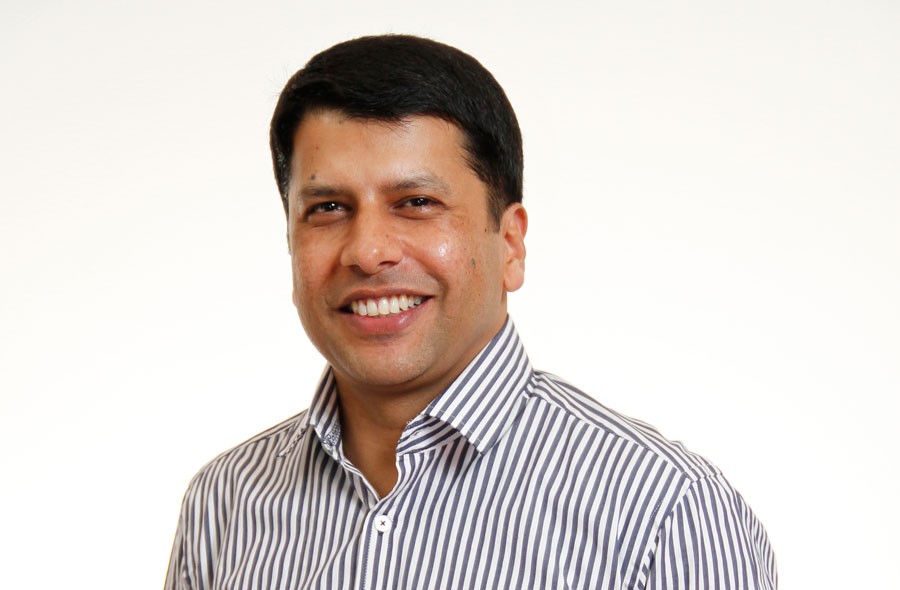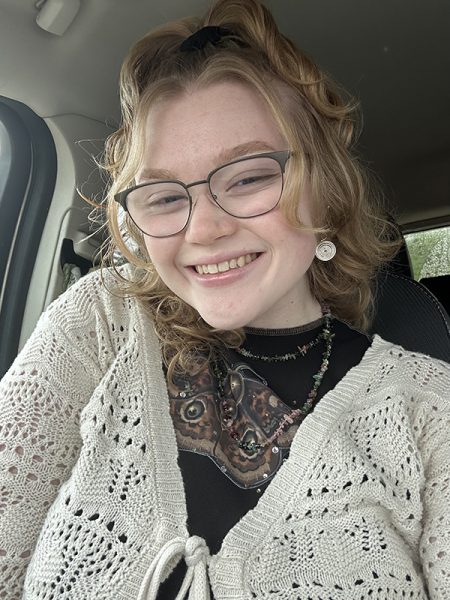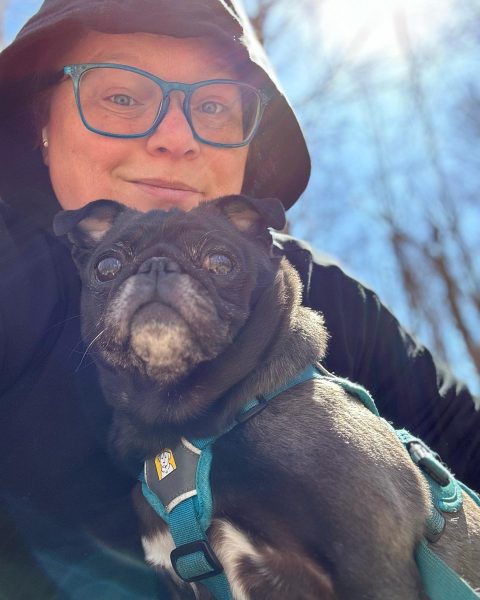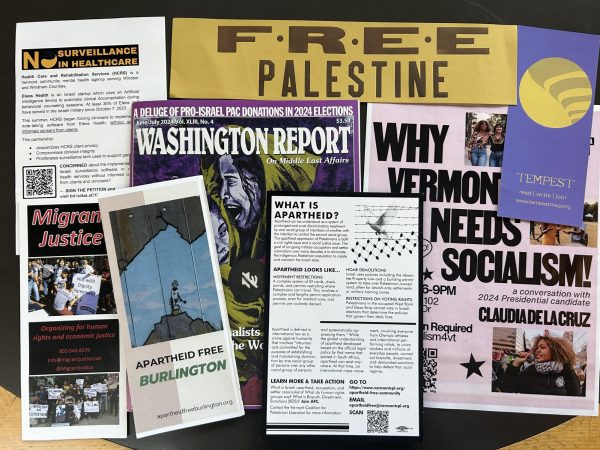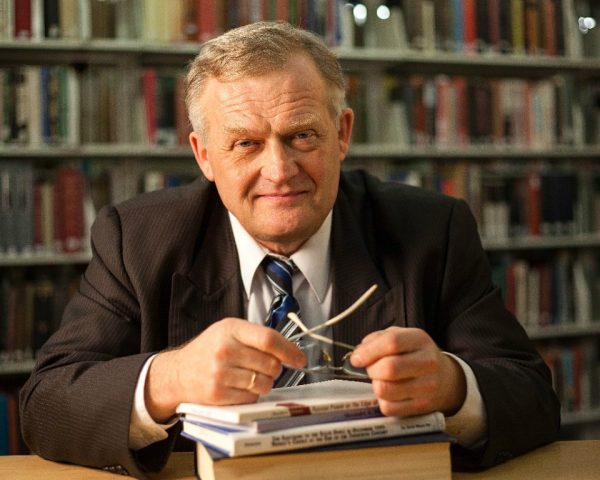The singular journey of Bidur Dahal
Bidur Dahal is reminiscing about his six-year-old self: “As a child in Bhutan I used to dream about helping people,” he says. The desire is a family trait passed down; for him, it is a God-given gift. “When I was young, I used to think for the village, not just for me. I was not the center point.”
In his Colchester apartment, Dahal sits on his tan, L-shaped couch. Next to him is his 19-month-old daughter, fast asleep. Upstairs, his 5-year-old son is eating vanilla ice cream, and on the wall is a small picture of a husband and wife wearing traditional Nepali clothing. They are Dahal’s parents.
The six-year-old Dahal couldn’t have imagined that less than a decade later his family would be fleeing their home to escape arrest.
He couldn’t have imagined the ways he would fulfill his dream: that he would help erect a refugee camp high school; that he would one day live in a country over 7,000 miles away, helping others who hope to find a new home in a foreign land.
Currently an interpreter and medical caseworker for the Vermont Refugee Resettlement Program, the state’s branch of the U.S. Committee for Refugees and Immigrants, Dahal provides in-house orientation for clients of all ages and nationalities.
Before this, Dahal worked in the Burlington School District as a paraeducator and liaison between Bhutanese refugees and the school community.
On Sundays, Dahal often stays home with his children while his wife works. She earned her LNA in Vermont while pregnant with their daughter.
Dahal wears track pants and a white polo shirt with stripes. His brown hair matches his brown eyes, and he speaks for minutes at a time, fast when excited. He is not shy, but is more reserved and careful than loud and boisterous. His honest smile and excitability feel authentic when you see it. The authenticity is often paired with quick nods and lifted eyebrows when he gets on a topic he is passionate about.
When he sees his listener understanding his point, or when one gives Dahal a smile or confirmative remark, his voice rises with a, “Yeah!” and his nod. The lull after his laughs and “yeahs” cause the mind to reflect, and it seems he is reflecting too.
To understand Dahal the Vermont resident- his hopes for his family and fellow refugees, one must first see Dahal the teenager, fleeing from Bhutan.
Dahal tells the story. The Bhutanese government was promoting a society of oneness- one type of dress, one language to be spoken. They began dictating what religious festivals could be celebrated, what foods could be eaten. The rule favored the Upper-class Buddhist population, while silencing the Nepali-speaking, predominantly Hindu, a people that made up an estimated one-sixth of the nation’s population.
Dahal recalls when he first started noticing the changes. “I was the last to study Nepali in Bhutan, up to grade six,” says Dahal, “And after that the Nepali books were burned by the government. Teaching the Nepali language was totally banned in Bhutan.”
Many would not comply with the government’s demands. These people included Dahal’s father and uncles. “My father was a very renowned priest. He never bowed down to the government to wear the dress that they wanted to provide,” says Dahal. As a teenager, Dahal was learning from the examples of his elders. He was learning to preserve culture while adapting to change. He describes his father as a loving, powerful, and generous man, who would help those poorer than him.
Dahal explains that his father and uncle came to know that some of the family was being targeted for arrest. Before anyone could be taken into custody, a Hindu policeman warned Dahal’s father, prompting him to flee.
Hundreds of families fled. It was this, or imprisonment. Speaking about family members who left before him, Dahal says, “They were leaving us behind, and we knew that they would not be able to come back again. We were scared all the time.”
Eventually, Dahal crossed the border with his uncle, and it wasn’t until a month later that he was reunited with his parents, finding them by coincidence while roaming around town.
It was a chaotic and quick exodus. Within a matter of weeks, thousands of Bhutanese became refugees in Nepal. From 1992-1996, over 100,000 refugees left Bhutan. Twenty-three years later some still hope to return to their old home.
Dahal’s daughter sleeps against the background of her father’s voice. His son comes down the stairs in the middle of the story, politely asking if he can talk to his dad. His request is an ice-cream refill.
After his son returns upstairs, Dahal continues, saying the early days as a refugee were the toughest. Parents couldn’t feed their children or themselves. Malnutrition related deaths and poor sanitation devastated refugee families. “After a year it got better,” says Dahal.
He grabs a green hardcover book of essays and diagrams. He flips through his Bachelor’s thesis, pointing to a full-page drawing of Beldangi 1, one of seven camps that were erected.
He points to one of the centimeter-sized boxes crammed together. The slightly larger boxes represent double-sized huts, allotted to families of seven and up. The small huts are made of bamboo, mud, and plastic. The camps function without electricity. The blueprint shows large squares for the school and medical centers.
It was in one of these schools, combined with time in an outside Nepali school where Dahal completed his high-school education.
Dahal realized he possessed something many of his fellow refugees did not, and set out to help his camp.
Dahal became a volunteer teacher with others who were educated through the high-school level. Dahal became part of a pioneer group that added high-school curriculum to his camp’s school.
Now, the young population of refugees who grow up in the camps have a better education than the Nepali natives who live in the surrounding farm areas.
As he grew older, Dahal continued his education. He was one of five refugees to be given a full scholarship to the Asian Institute of Technology, where he received his Master’s of Science in Environmental Technology and Management.
Later, he worked as a researcher in Thailand, studying air pollution, and during another few-years’ stent he worked as a political journalist.
Dahal speaks about the resilience of his people and uses his hands to grab at an invisible sphere in front of him. The sphere is unity. “Culture bound us, it’s not the rule and regulations and strict, stringent monitoring or something,” says Dahal. He speaks from the perspective of the refugees as a whole.
“Culture was their rule, culture was their regulation, culture was everything. It was our constitution.”
Dahal highlights how this defied troubles that normally arise in society: religious differences, the changing political landscape in Nepal and how these can tear apart community and put people at odds with one another. Dahal is proud when he says these disputes did not penetrate the refugee camps and that the crime rate inside was and still is extremely low.
In 2007 the United Nations began a program to resettle the refugees to nations that might provide them with a better way of living and a possibility of citizenship. Many understood that they would never return to Bhutan.
According to a September 2014 report by the UN Refugee Agency, over 92,500 Bhutanese refugees have resettled in eight countries, nearly 70,000 of whom are in the United States.
Dahal says between 1700-1900 refugees have resettled in the Green Mountain state.
He was drawn to Vermont because of the closeness of everything, desiring something better than his minimum-wage sales associate job in Iowa, where he first resettled. There, he had a two-hour round trip for work. Moving to Vermont was a tough decision, as it meant leaving his parents once again.
He says Vermont has something unique: refugees will have a friend or family member who is already living here. Dahal says the state emphasizes and assures these ties, so newly resettled refugees will have someone to help them in the initial days of resettlement. This is partnered with the role of the VRRP and its caseworkers, who continue helping in the resettlement process.
Dahal’s first job in Vermont was as a paraeducator in the Burlington School District, where he worked alongside English speakers as well as English language learners (ELL). Later he worked with groups of ELL students and teachers, helping both populations with interpretive services. His final job in the district was another liaison position, where he connected the refugee community with the school community in the same ways.
Dahal delves into the hardships of new refugees, and how many of the younger children in elementary grades would be upset and cry. Almost on cue, Dahal’s 19-month-old daughter wakes up from her nap with cries of her own.
He picks her up and begins rocking her back forth. He switches from talking about himself to talking to his daughter in a calming tone. Dahal finishes the last 35 minutes of the interview on his feet, with his daughter’s curly-haired head resting on his chest.
It is during this time where Dahal speaks about the responsibilities of living in a diverse community— to understand each other’s culture and background.
Dahal relates this to his current passion-driven project he titles “Culturally-linguistically sensitive healthcare approaches.” He is working on a presentation he will share with UVM medical students. It will focus on how healthcare workers can adapt their methods to the changing population.
It won’t be the first time Dahal has spoken in front of a crowd about what he believes in. Another note of passion is the civil liberties of his new home. Speaking about the right to vote, Dahal says, “I have told in many different conferences that a lot of people take this civic right for granted. It’s very dear and very near to me.”
He feels proud to be part of a society that has open elections. “I’ve never voted so far in any general election and I’m longing to be a citizen of America,” he says. “I think I’ll be able to vote in 2020’s election. I’ll be the first person go out and vote.”
With new goals in mind, Dahal says the close-knit culture of camp life has survived in Vermont, despite the obstacles of transportation, parental responsibilities, and the fact that many refugees can’t read or understand English.
He hopes his fellow Bhutanese will learn English, become active members of society, and teach their children to do the same. “I would love to see our community in their own decision making rather than expecting someone else to solve their problems. Be self sufficient.”
Dahal believes this is beginning to happen, noting that 45 Bhutanese families have bought homes in Vermont. “We want to be citizens, be residents, have a better self-sufficient life,” says Dahal. “We want to see our children growing, prospering, and we adults progressing. We have those high hopes, and positive attitude towards life, and you can see these things in every [Bhutanese] family wherever you go.”
If you ask him why he holds onto these hopes, and why he wants others to share in these, he might tell you a story about a six-year-old boy lying in bed, wondering how he can help his village.
As a father, a community member, and caseworker, he’s finding ways to help in his new village: “I feel good when I can help. That gives me so much satisfaction. I feel so good when I see a smile on a person’s face when I provide the right information at the right time. That gives me enough motivation and inspiration.”
Travis LeClair joined the Basement Medicine staff in Spring 2014, assuming the position of staff reporter.


